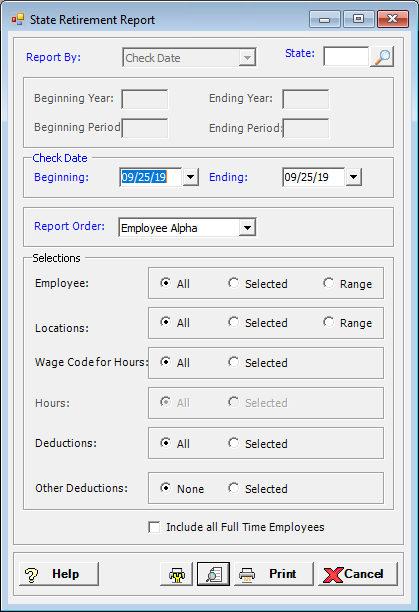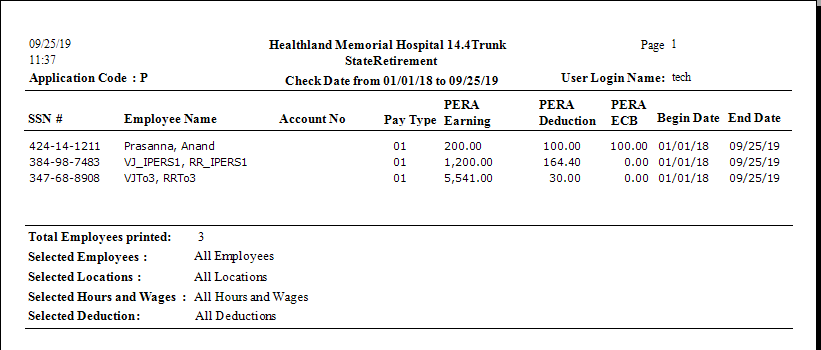
The State Retirement Report window allows you to generate a report showing which employees receive PERA and/or other state retirement deductions. The amounts deducted from each employee's paycheck and the total amount deducted for each type of state retirement code are included on the report.
Be sure the employee's state retirement account number is entered in the employee record (Employees > General tab). Currently used for Minnesota sites only for PERA reporting.
To access the State Retirement Report window, go to Payroll > Reports > State Retirement > State Retirement Report. [+]
In the Report By field, use the drop-down list to select the option to base the report. Choose from the following options. NOTE: Currently, Check Date is the only valid option.
Period - To show state retirement deductions based on the selected fiscal time period.
Check Date - To show state retirement deductions based on the selected range of check dates.
Period Ending Date - To show state retirement deductions based on the selected range of period ending dates.
Choose from the following options based the Report By selection:
If reporting by Period, enter the time period to include in the report. Enter the first fiscal year of the range in the Beginning Year field, and the last fiscal year of the range in the Ending Year field. Enter the first fiscal period of the range in the Beginning Period field, and the last fiscal period of the range in the Ending Period field.
If reporting by Check Date, enter a range of check dates to include in the report. By default, the current date is displayed. To run the report for a different or longer period of time, enter the first date of the range in Beginning Date field, and the last date of the range in the Ending Date field. Use the drop-down calendar in each field to select the date. The ending date must be equal to or greater than the beginning date.
If reporting by Period Ending Date, enter a range of period end dates to include in the report. By default, the current date is displayed. To run the report for a different or longer period of time, enter the first date of the range in Beginning Date field, and the last date of the range in the Ending Date field. Use the drop-down calendar in each field to select the date. The ending date must be equal to or greater than the beginning date.
In the Report Order field, use the drop-down list to select how to sort the report. Choose from the following options:
Employee No. - To print in alphanumeric order by employee number.
Employee Alpha - To print in alphabetical order by employee name.
In the Employees, Locations, Wage Code for Hours, Hours, and Deductions fields, specify the employees, locations, wage codes for hours, hours, and deductions to include in the report. Select All (default), or choose Selected or Range (as available) to specify which ones to include. See Reporting/Printing Functions for detailed information on using the Selected and Range options.
The Other Deductions field is used to include deductions that are set up in the "Z-Other" category. Select None or Selected. The Selected option displays a screen for you to select the deductions you want to include in report. The "Other" deductions are reflected in the report under the Deferred Deduction column with the 8, 9, and C unit deductions.
Check the Include all Full Time Employees box to include full-time employees with state retirement deductions.
Click the Preview button (located to the left of the Print button) to view the State Retirement Report in the Report Viewer, or click Print to print the report to the designated printer. See Reporting/Printing Functions for detailed information on using the Printer Settings and Print Preview buttons.
Click Cancel to exit.
State Retirement Deduction Report Example
